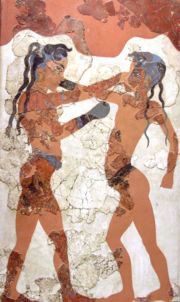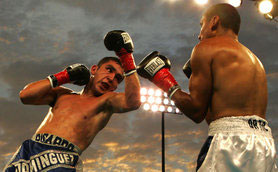影片对白 I gotta leave you, Frankie.
文化面面观
Boxing: 拳击的起源与发展
Boxing, sport of fighting with fists, also called pugilism and prizefighting.
Early History
 |
| Youths boxing in a Minoan fresco on the Greek island of Santorini |
Depicted on the walls of tombs at Beni Hasan in Egypt, dating from about 2000 to 1500 B.C., boxing is one of the oldest forms of competition. A part of the ancient Olympic games, the sport was exhausting and brutal. The Greeks fought without regard for weight differentials and without interruption, a match ending only when a fighter lost consciousness or raised his hand in resignation. Boxers wound heavy strips of leather around their hands and wrists. Under Roman rule, these thongs (the caestus) were laced with metal, ensuring an abundance of blood. Statues of maimed boxers from late antiquity attest to the carnage. After the demise of the Olympics, boxing survived as a common sport. It persisted at local fairs and religious festivals throughout medieval Europe and was especially popular in the west and north of England, where it was often a combination of wrestling and street fighting.
The Organization of Boxing
In early 18th-century England, boxing, with the aid of royal patronage in the form of betting or offering prizes, became organized. James Figg, the first British champion (1719–30), opened a School of Arms, which attracted numerous young men to instruction in swordplay, cudgeling, and boxing—the “manly arts of self-defense.” After delivering a fatal blow in a bout, Jack Broughton drew up (1743) the first set of rules. Though fights still ended only in knockout or resignation, Broughton's rules moderated the sport and served as the basis for the later London Prize-ring Rules (1838) and Queensbury Rules (1867). The latter called for boxing gloves, a limited number of 3-min rounds, the forbidding of gouging and wrestling, a count of 10 sec before a floored boxer is disqualified, and various other features of modern boxing.
Boxing in the United States

|
| Professional boxing bout featuring Ricardo Domínguez (left, throwing a left uppercut) versus Rafael Ortiz |
Until late in the 19th cent., American fighters established their own rules, which were few. Early matches, some of them free-for-alls, featured biting and gouging as well as punching. In most instances they were also illegal. In 1888, John L. Sullivan, a bare-knuckle champion and America's first sports celebrity, won a clandestine 75-round match.
New York legalized boxing in 1896, and other states soon followed suit. Although the reign (1910–15) of the first African-American heavyweight champion, Jack Johnson, disturbed the segregated society of the time, and although many continued to question boxing's social purpose, its inclusion in the Olympic games in 1904, its use for military training in World War I, its emergence as a source of discipline for youth, its regulation by state commissions, and its suggestion of national vitality strengthened its claims to legitimacy and bolstered its popularity through the 1920s and 30s. Heavyweight (over 190 lb/86.3 kg) champions Jack Dempsey (1919–26) and Joe Louis (1937–49) were national heroes, Louis becoming one of the first black athletes to gain wide popularity.
Since World War II, boxing has proceeded amid corruption and, at times, chaos. Rising admission prices, restriction of title fights to closed-circuit television, the proliferation of organizations claiming to sanction fights and proclaim champions, financial scandals, ring injuries and deaths, monopolistic practices by promoters, and claims of exploitation of lower-class fighters have threatened its appeal, yet the sport continues to attract huge audiences and investment. Great fighters like Muhammad Ali elicit admiration and fascination, while controversy surrounds others like the repeatedly imprisoned Mike Tyson. Lennox Lewis is generally regarded as the current world heavyweight champion. (answers.com)
考考你
用今日所学将下面的句子译成英语。
1. 随时来走走。
2. 万一另一次世界大战爆发,人类将会发生什么事?
3. 把电话挂了好吗?你都讲了这么久了。
Million dollar baby《百万美元宝贝》精讲之二 考考你 参考答案
1. 你做这一切就是为了戏弄我吗?
You’ve done all these just to wind me up?
2. 我不明白他为什么说那些话。
I can't figure out why he said that.
3. 他把仅有的几件东西捆成一捆。
He rolled up his few possessions.
影片对白 I gotta leave you, Frankie.
点击进入:更多精彩电影回顾
(英语点津Annabel编辑)